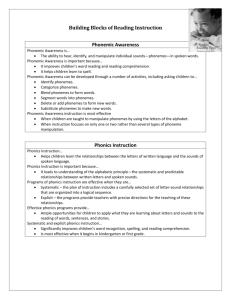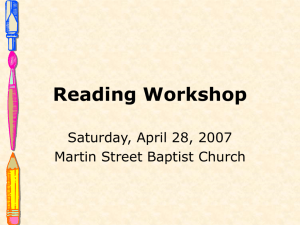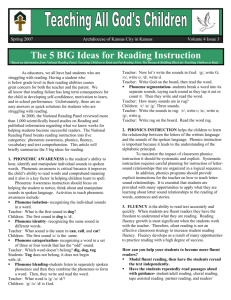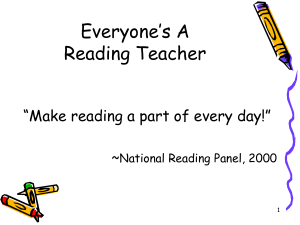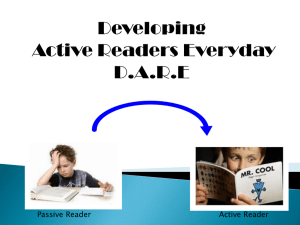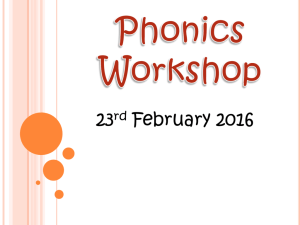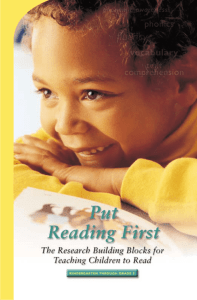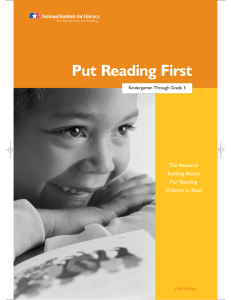The Five Components of Reading
advertisement
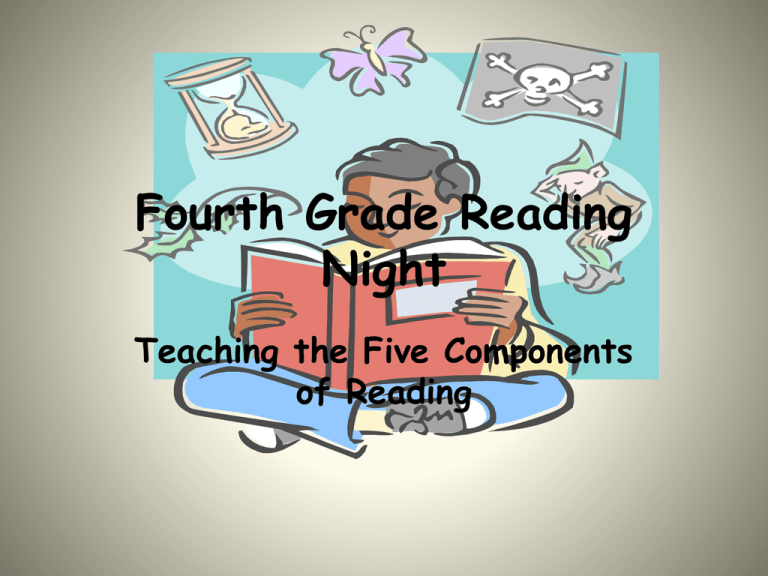
Fourth Grade Reading Night Teaching the Five Components of Reading Introduction Reading is an astoundingly complex cognitive process. While we often think of reading as one singular act, our brains are actually engaging in a number of tasks simultaneously each time we sit down with a book. There are five aspects to the process of reading • Phonic • phonemic awareness • Vocabulary • Reading comprehension • Fluency. These five aspects work together to create the reading experience. As children learn to read they must develop skills in all five of these areas in order to become successful readers. Phonics Phonics is the connection between sounds and letter symbols. It is also the combination of these sound-symbol connections to create words. Learning to make that connection between the individual sounds that each letter represents and then putting those together is essential to understanding what that funny squiggle means. Readers are taught to first connect letters to their corresponding phonemes (sound units) and then to blend those together to create a word. A word is identified as a whole unit and then its letter-sound connections are parsed out. Analogy phonics uses familiar parts of words to discover new words. Finally, phonics through spelling focuses on connecting sounds with letters in writing. Phonemic Awareness Phonemic awareness is closely related to phonics because both involve the connection between sounds and words. While phonics is the connection between sounds and letters, phonemic awareness is the understanding that words are created from phonemes (small units of sound in language). These may seem like the same thing, but there is a subtle difference in the two. Phonics is used only in written language because it involves letters. Phonemes are sounds only. A Closer Look Phoneme isolation involves the reader parsing out the individual sounds in a word in order to determine its meaning. Similarly, phoneme segmentation asks the reader to break words into their corresponding phoneme to figure out the new word. Phoneme identification relies on the reader’s general knowledge of phonemes to identify sound patterns in words. For example a reader would identify the phoneme /d/ he knows from the words “dog” and “dad” to help him learn how to read a new word “doctor”. Finally, phoneme blending requires the reader to connect a series of phonemes together to create a word. Vocabulary In order to read words we must first know them. Imagine how frustrating and fruitless it would be to read this article if all of the words were unfamiliar to you. As children become stronger, more advanced readers they not only learn to connect their oral vocabularies (the words we know when they are spoken) to their reading vocabularies (the words we know when they are used in print) they also strengthen each of these areas by adding new words to their repertoires. Vocabulary development is an ongoing process that continues throughout one’s “reading life”. There are two primary ways of teaching and learning new vocabulary words. • The first is explicit instruction. This involves someone telling you how a word is pronounced and what its meaning is. That “someone” might be a teacher, a dictionary, a vocabulary guide or any other resource offering definitions and pronunciations. • Context clues provide another method for discovering new words. Context clues are the “hints” contained in a text that help a reader figure out the meaning of an unfamiliar word. They include other words in a sentence or paragraph, text features (ie. bold print, italics), illustrations, graphs and charts. Context clues are basically any item in the text that points to the definition of a new word. Fluency Fluency is a reader’s ability to read with speed, accuracy and expression. Thus it requires him to combine and use multiple reading skills at the same time. While fluency is most often measured through oral readings, good readers also exhibit this skill when they are reading silently. Think about the way a book “sounds” in your mind when you are reading silently. You “hear” the characters “speak” with expression. Even passages that are not written in dialogue “sound” as if the words fit the meaning. A particularly suspenseful action sequence moves quickly through your mind creating a palpable sense of tension. Your ability to move through a piece of text at a fluid pace while evoking the meaning and feeling of it demonstrates your fluency. Comprehension Comprehension is what most people think reading is. This is because comprehension is the main reason why we read. It is the aspect of reading that all of the others serve to create. Reading comprehension is understanding what a text is all about. It is more than just understanding words in isolation. It is putting them together and using prior knowledge to develop meaning. Reading comprehension is the most complex aspect of reading. It not only involves all of the other four aspects of reading, it also requires the reader to draw upon general thinking skills. When a reader is actively engaged with a text, she is asking and answering questions about the story and summarizing what she has read. Like vocabulary, reading comprehension skills develop and improve over time through instruction and practice. How can you help Improve your child’s reading? 1. Work with his/her teacher. 2. Encourage them to read at least 20 minutes a night. 3. Listen to them read 4. Ask the Five W’s: Who, What, When, Where, Why


